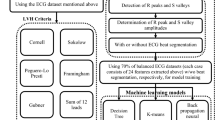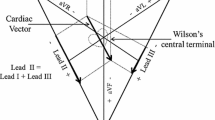Abstract
This work proposes a novel method for the detection of Left Ventricular Hypertrophy (LVH) from a multi-lead ECG signal. Left Ventricle walls become thick due to prolonged hypertension which may fail to pump heart effectively. The imaging techniques can be used as an alternative diagnose LVH; however, they are more expensive and time-consuming than proposed LVH. To overcome this issue, an algorithm to the diagnosis of LVH using ECG signal based on machine learning techniques were designed. In LVH detection, the pathological attributes such as R wave, S wave, inversion of QRS complex, changes in ST segment noticed in the ECG signal. This clinical information extracted as a feature by applying continuous wavelet transform. The signals were reconstructed with the frequency between 10 and 50 Hz from the wavelet. This followed by the detection of R wave and S wave peaks to obtain the relevant LVH diagnostic features. The Support Vector Machine (SVM), K-Nearest Neighbor (KNN), Ensemble of Bagged Tree, AdaBoost classifiers were employed and the results are compared with four neural network classifiers including Multilayer Perceptron (MLP), Scaled Conjugate Gradient Backpropagation Neural Network (SCG NN), Levenberg–Marquardt Neural Network (LMNN) and Resilient Backpropagation Neural network (RPROP). The data source includes Left Ventricular Hypertrophy and healthy ECG signal from PTB diagnostic ECG database and St Petersburg INCART 12-Lead Arrhythmia Database. The results revealed that the proposed work can diagnose LVH successfully using neural network classifiers. The accuracy in detecting LVH is 86.6%, 84.4%, 93.3%,75.6%, 95.6%, 97.8%, 97.8%, 88.9% using SVM, KNN, Ensemble of Bagged Tree, AdaBoost, MLP, SCG NN, LMNN and RPROP classifiers, respectively.






Similar content being viewed by others
References
Bacharova L, Harvey Estes E (2017) Left ventricular hypertrophy by the surface ECG. J Electrocardiol 50(6):906–908
Linhart A, Cecchi F (2018) Common presentation of rare diseases: Left ventricular hypertrophy and diastolic dysfunction. Int J Cardiol 257:344–350
Pinto J, George P, Hegde N (2014) Study in Southern India among hypertensive patients using ecg to screen left ventricular hypertrophy-can we do it in rural health centres? J Clin Diagn Res JCDR 8(3):59
Schillaci G, Verdecchia P, Borgioni C, Ciucci A, Guerrieri M, Zampi I, Battistelli M, Bartoccini C, Porcellati C (1994) Improved electrocardiographic diagnosis of left ventricular hypertrophy. Am J Cardiol 74(7):714–719
Yang X, Fan D, Ren A, Zhao N, Shah SA, Alomainy A, Ur-Rehman M, Abbasi Qammer H (2020) Diagnosis of the Hypopnea syndrome in the early stage. Neural Comput Appl 32(3):855–866
Sharma LN, Tripathy RK, Samarendra D (2015) Multiscale energy and eigenspace approach to detection and localization of myocardial infarction. IEEE Trans Biomed Eng 62(7):1827–1837
Kumar KS, Babak Y, Rajesh Kumar P (2015) Removal of noise from electrocardiogram using digital FIR and IIR filters with various methods. In: 2015 International conference on communications and signal processing (ICCSP), pp 0157–0162. IEEE
Amin W, Davis MR, Thomas GA, Holloway DS (2013) Analysis of wave slam induced hull vibrations using continuous wavelet transforms. Ocean Eng 58:154–166
Stepanov AB (2017) Wavelet analysis of compressed biomedical signals. In: Open innovations association (FRUCT), 20th Conference of 2017, pp 434–440. IEEE
Provaznik I (2002) Wavelet analysis for signal detection—application to experimental cardiology research. Ph.D. dissertation, Dept. Biomed. Eng., Brno University of technology
Nayak SK, Banerjee I, Pal K (2019) Electrocardiogram signal processing-based diagnostics: applications of wavelet transform. In: Pal K, Kraatz H-B, Khasnobish A, Bag S, Banerjee I, Kuruganti U (eds) Bioelectronics and Medical Devices, pp 591–614. Woodhead Publishing, Cambridge
Addison PS (2018) Introduction to redundancy rules: the continuous wavelet transform comes of age. Philos Trans R Soc A Math Phys Eng Sci 376(2126):1–15
Veroy KPL (2000) Time-frequency analysis of Lamb waves using the Morlet wavelet transform.” Ph.D. diss., Massachusetts Institute of Technology
Baloglu UB, Talo M, Yildirim O, San Tan R, Rajendra Acharya U (2019) Classification of myocardial infarction with multi-lead ECG signals and deep CNN. Pattern Recogn Lett 122:23–30
Turhan M, Şengur D, Karabatak S, Guo Y, Smarandache F (2018) Neutrosophic weighted support vector machines for the determination of school administrators who attended an action learning course based on their conflict-handling styles. Symmetry 10(5):176
Hofmann M (2006) Support vector machines—Kernels and the kernel trick. Notes 26:1–16
Parikh KS, Shah TP (2016) Support vector machine–a large margin classifier to diagnose skin illnesses. Proc Technol 23:369–375
He R, Wang K, Li Q, Yuan Y, Zhao N, Liu Y, Zhang H (2017) A novel method for the detection of R-peaks in ECG based on K-nearest neighbors and particle swarm optimization. EURASIP J Adv Signal Process 2017(1):82
Malini Suvarna V (2015) Performance measure and efficiency of chemical skin burn classification using KNN Method. In: International conference on eco-friendly computing and communication systems, ICECCS2015, no. 70, pp 48–54
Saini I, Singh D, Khosla A (2013) QRS detection using K-Nearest Neighbor algorithm (KNN) and evaluation on standard ECG databases. J Adv Res 4(4):331–344
Acharya UR, Fujita H, Sudarshan VK, Sree VS, Eugene LWJ, Ghista DN, SanTan R (2015) An integrated index for detection of sudden cardiac death using discrete wavelet transform and nonlinear features. Knowledge-Based Syst 83(2015):149–158
Li Y, Cui W (2019) Identifying the mislabeled training samples of ECG signals using machine learning. Biomed Signal Process Control 47:168–176
Zareapoor M, Shamsolmoali P (2015) Application of credit card fraud detection: based on bagging ensemble classifier. Proc Comp Sci 48(2015):679–685
Al-Barazanchi KK, Al-Neami AQ, Al-Timemy AH (2017) Ensemble of bagged tree classifier for the diagnosis of neuromuscular disorders. In: Advances in Biomedical Engineering (ICABME), 2017 Fourth International Conference on, pp 1–4. IEEE
Fraz MM, Remagnino P, Hoppe A, Uyyanonvara B, Rudnicka A, Owen CG, Barman SA (2012) Retinal vessel segmentation using ensemble classifier of bagged decision trees. In: Image processing (IPR 2012), IET conference on, pp 1–6
Acharya UR, Faust O, Kadri NA, Suri JS, Yu W (2013) Automated identification of normal and diabetes heart rate signals using nonlinear measures. Comput Biol Med 43(10):1523–1529
Wang R (2012) AdaBoost for feature selection, classification and its relation with SVM, a review. Phys Proc 25:800–807
Tharwat A (2016) Linear vs. quadratic discriminant analysis classifier: a tutorial. Int J Appl Pattern Recogn 3(2):145–180
Ramchoun H, Idrissi MAJ, Ghanou Y, Ettaouil M (2016) multilayer perceptron: architecture optimization and training. IJIMAI 4(1):26–30
Kora P, Kalva SRK (2017) Detection of bundle branch block using adaptive bacterial foraging optimization and neural network. Egypt Inf J 18(1):67–74
Damodara VD, Arokiaraj A, Chen DH, Lou HH, Martin Christopher, Li Xianchang (2020) Flare performance modeling and set point determination using artificial neural networks. Int J Energy Environ Eng 11(1):91–109
Nayak S, Kumar N, Choudhury BB (2017) Scaled conjugate gradient backpropagation algorithm for selection of industrial robots. Int J Comput Appl 7(6):2250–1797
Prasad N, Rajeshni S, Sunil PL (2013) Comparison of back propagation and resilient propagation algorithm for spam classification. In: 2013 Fifth international conference on computational intelligence, modelling and simulation, pp. 29–34. IEEE
Govindarajan P, Soundarapandian R, Gandomi AH, Patan R, Jayaraman P, Manikandan R (2020) Classification of stroke disease using machine learning algorithms. Neural Comput Appl 32(3):817–828
Imam MH, Karmakar CK, Jelinek HF, Palaniswami M, Khandoker AH (2016) Detecting subclinical diabetic cardiac autonomic neuropathy by analyzing ventricular repolarization dynamics. IEEE J Biomed Health Inf 20(1):64–72
Chang P-C, Lin J-J, Hsieh J-C, Weng J (2012) Myocardial infarction classification with multi-lead ECG using hidden Markov models and Gaussian mixture models. Appl Soft Comput 12(10):3165–3175
Author information
Authors and Affiliations
Corresponding author
Ethics declarations
Conflict of interest
This manuscript is not submitted in any journal and none of the co-authors having any conflict to submit and process our manuscript in this Journal.
Additional information
Publisher's Note
Springer Nature remains neutral with regard to jurisdictional claims in published maps and institutional affiliations.
Rights and permissions
About this article
Cite this article
Jothiramalingam, R., Jude, A., Patan, R. et al. Machine learning-based left ventricular hypertrophy detection using multi-lead ECG signal. Neural Comput & Applic 33, 4445–4455 (2021). https://doi.org/10.1007/s00521-020-05238-2
Received:
Accepted:
Published:
Issue Date:
DOI: https://doi.org/10.1007/s00521-020-05238-2




